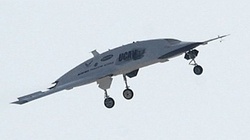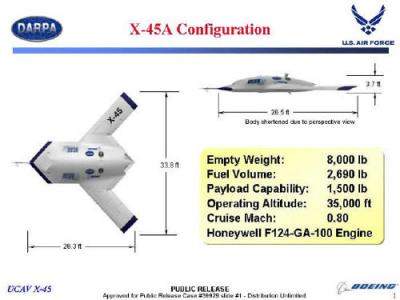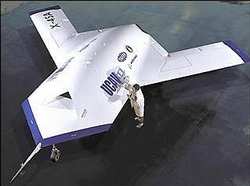Boeing/DARPA Demonstration Proves It
 In a
new block of demonstrations in the Unmanned Combat Air Vehicle
(UCAV) program, Boeing and DARPA (the Defense Advanced Research
Projects Agency) have successfully demonstrated that an autonomous
unmanned aircraft controlled from the ground could be successfully
integrated into air-traffic-controlled airspace with manned
aircraft.
In a
new block of demonstrations in the Unmanned Combat Air Vehicle
(UCAV) program, Boeing and DARPA (the Defense Advanced Research
Projects Agency) have successfully demonstrated that an autonomous
unmanned aircraft controlled from the ground could be successfully
integrated into air-traffic-controlled airspace with manned
aircraft.
"Air Force leadership has made it very clear that the UCAV
system must interoperate within the manned environment," said Andy
Gutierrez, the government X-45A chief systems engineer. "Manned
airspace control procedures are not going to substantially change
and the design of the UCAV must adapt so that it can safely and
effectively operate in such an environment. This demo has taken a
giant first step towards making manned and unmanned systems
co-exist."
The Human as Redundant System; UAV Has a Stand-In
 The demonstration, the first of the UCAV Block 2
capabilities, was conducted at Edwards and Eglin Air Force bases
using the T-33 UCAV Surrogate aircraft. Equipped with an avionics
pallet fully representative of the X-45A UCAV system, the T-33 can
autonomously fly pre-planned mission routes while also having a
hands-off test pilot aboard to take manual control if necessary to
ensure operational safety. This approach also allows operators on
the ground to control the T-33 as if it were a UCAV.
The demonstration, the first of the UCAV Block 2
capabilities, was conducted at Edwards and Eglin Air Force bases
using the T-33 UCAV Surrogate aircraft. Equipped with an avionics
pallet fully representative of the X-45A UCAV system, the T-33 can
autonomously fly pre-planned mission routes while also having a
hands-off test pilot aboard to take manual control if necessary to
ensure operational safety. This approach also allows operators on
the ground to control the T-33 as if it were a UCAV.
As the T-33 autonomously flew pre-planned routes around Edwards
and Eglin, operators in the UCAV mission control station on the
ground interacted with air traffic controllers to alter the
T-33’s flight as necessary for air traffic separation,
de-confliction, holding, and simulated missed approaches. None of
the actions adversely affected base tempo and day-to-day
operations, and feedback from airspace controllers was
favorable.
"This flight demonstration provided the UCAV team with a unique
opportunity to integrate the UCAV system into a high operations
tempo airspace with manned aircraft," said Mike Harlan, X-45A test
and operations manager for the Boeing Phantom Works advanced
R&D unit. "Using our surrogate aircraft not only increases
flight safety, it also allows us to evaluate our system much
earlier in the development cycle and provide a more mature product
for our customer."
It's been going on a long time...
The demonstration began in February 2003 with five flights at
the NASA Dryden Flight Research Center, Edwards Air Force Base
(CA). These initial flights were conducted to verify airspace
procedures and basic functionality in a low tempo environment. The
T-33 surrogate UCAV was flown in and out of controlled airspace
multiple times per flight, integrating with other aircraft in the
traffic pattern.

Another eight missions were conducted this month at Eglin Air
Force Base (FL). Since Eglin AFB has a higher tempo of operations
that includes military, commercial, rotorcraft, and general
aviation aircraft, the UCAV system and operator performance could
be evaluated under more realistic high task loading conditions.
Flown From the Ground, too:
 As another milestone, the flight demonstration was
the first use of Link-16 data link to remotely operate an air
vehicle from the ground. Link-16 is a high capacity, anti-jam,
secure communication system and the data link of choice for the US
and its NATO allies.
As another milestone, the flight demonstration was
the first use of Link-16 data link to remotely operate an air
vehicle from the ground. Link-16 is a high capacity, anti-jam,
secure communication system and the data link of choice for the US
and its NATO allies.
"These surrogate UCAV demonstration flights are an essential
element in our strategy to assure interoperability in manned
airspace," said Col. Earl Wyatt, UCAV program manager for the U.S.
Air Force. "Our demonstration program is aggressively reducing risk
on a path to a robust operational UCAV system."
As the initial Block 2 demonstration flights were being
conducted with the T-33 UCAV Surrogate, Block 1 demonstrations with
the X-45A UCAV were being successfully completed at NASA Dryden.
During Block 1, 48 discrete laboratory, simulation and flight
demonstrations were conducted, primarily focused on initial systems
checkout. The demonstrations included a total of 16 individual test
flights of the two X-45A air vehicles.
The UCAV program is a joint DARPA/U.S. Air Force/Boeing effort
to demonstrate the technical feasibility, military utility and
operational value of a UCAV system to effectively and affordably
prosecute 21st century lethal and non-lethal suppression of enemy
air defenses and strike missions within the emerging global command
and control architecture. The X-45A is demonstrating the technical
feasibility of the UCAV concept. The program is now designing a
more operationally representative prototype that will demonstrate
the military utility and operational value of the UCAV system.
The X-45A UCAV system is being developed by the Boeing Phantom
Works, which is the advanced R&D unit and catalyst of
innovation for the Boeing enterprise. By working with the company's
business units, it provides advanced solutions and innovative,
breakthrough technologies that reduce cycle time and cost while
improving the quality and performance of aerospace products and
services.
 NTSB Final Report: Dehavilland DHC-2 MK 1
NTSB Final Report: Dehavilland DHC-2 MK 1 Aero-News: Quote of the Day (10.29.25)
Aero-News: Quote of the Day (10.29.25) ANN's Daily Aero-Linx (10.29.25)
ANN's Daily Aero-Linx (10.29.25) ANN's Daily Aero-Term (10.30.25): Minimum Friction Level
ANN's Daily Aero-Term (10.30.25): Minimum Friction Level ANN's Daily Aero-Linx (10.30.25)
ANN's Daily Aero-Linx (10.30.25)






